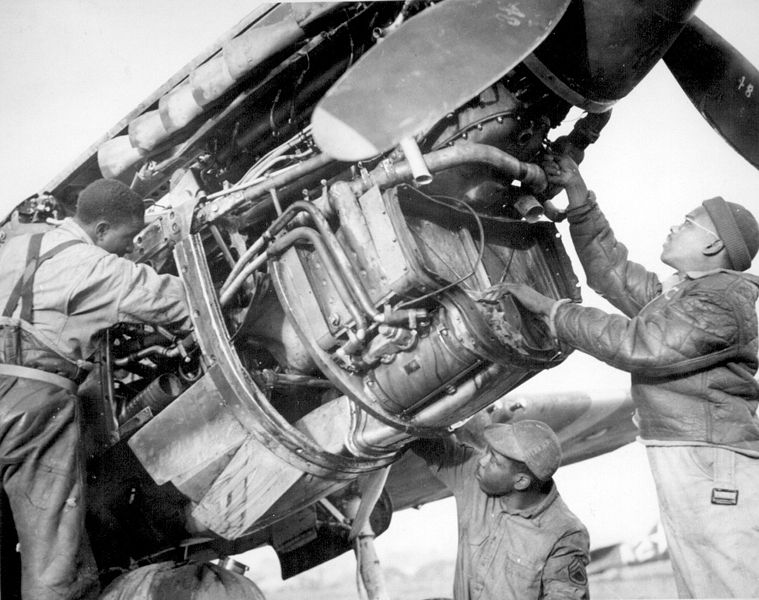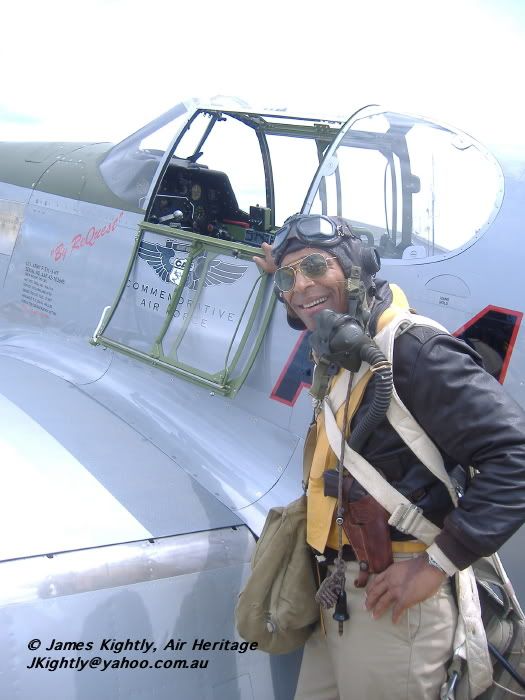 Kermit Weeks' P-51C in the colours of the Tuskegee Airmen. Author.
Kermit Weeks' P-51C in the colours of the Tuskegee Airmen. Author.The story of the Tuskegee Airmen is now well documented. A brief overview for background here:
The Tuskegee Airmen were the first African Americans to be trained as WWII Military pilots in the U.S. Army Air Corps. This was a time when being black was more of a crime than being the enemy. Never in our nations' history had the idea of enemy lines been so blurred or had patriotism been so clearly defined. The Tuskegee Airmen challenged America's racist attitudes with the willingness to give their lives to a country not willing to serve them.
There were 992 pilots trained at Tuskegee, Alabama while over 10,000 Black maintenance personnel trained at Chanute Field in Illinois. Five hundred and fifty bomber pilots and their crews were trained but the war ended before they were deployed overseas. The remaining 445 fighter pilots and their crews entered combat in Europe, the Mediterranean and North Africa. The Tuskegee Airmen were forced to operate as segregated units and not allowed to train or fight alongside their white fellow countrymen. To identify themselves they painted the tails of their aircraft red, thus becoming the "Red Tails". The Tuskegee Airmen "Red Tails" carried the hopes and dreams of equality for themselves and their thirteen million African American countrymen into battle.
 As is often the case, the men who supported the fliers can be overlooked. The Tuskegee airmen were supported by their own black ground crew, as a segregated African-American unit. (Mechanics of 99th FS "Tuskegee Airmen" (332nd Fighter Group-15th USAAF) repairing P-40 engine.) USAF Official.
As is often the case, the men who supported the fliers can be overlooked. The Tuskegee airmen were supported by their own black ground crew, as a segregated African-American unit. (Mechanics of 99th FS "Tuskegee Airmen" (332nd Fighter Group-15th USAAF) repairing P-40 engine.) USAF Official.Shunned initially, the Red Tail pilots and their crews overcame the dire circumstances of discrimination and their performance became legendary. They soon became the “requested” fighter escorts by the white bomber pilots. Flying over 15,000 sorties in more than 1,500 missions, they compiled an outstanding combat record. As bomber escorts, the Tuskegee Airmen lost very few bombers to enemy fighters, which earned them the nickname "Red Tail Angels". Sixty-six gave their lives in combat and 32 were captured as prisoners of war.More details here and here.
 A recreator with the Minnesota Wing 'Red Tail' P-51C Mustang 'By Request' at Oshkosh 2009. Author.
A recreator with the Minnesota Wing 'Red Tail' P-51C Mustang 'By Request' at Oshkosh 2009. Author.Beyond the incredible achievement of these young black men is the way their story has become an exemplar for a focus on a disadvantaged minority in aviation. Today there is extensive coverage of the red tails in numerous places and media. Some are quite surprising, like the Commemorative Air Force's (CAF) 'Red Tail' P-51C Mustang. While this aircraft is actually operated by the Minnesota Wing of the CAF, it shows how far the CAF (who were, of course, famously the Confederate Air Force - a witty riff on their Texan origins but not a joke to some, resulting in an enforced name change in 2002.)
As the Minnesota Wing website states:
The decision was made to paint this rare aircraft in the distinctive colors of the Tuskegee Airmen~ the 332nd Fighter Group ~ and, in so doing, honor these long neglected heroes who, during World War II, accomplished a "double victory"; one over nazism and the other over racism. The importance and justification of this decision was ratified by the Minnesota Legislature with a substantial monetary grant towards its ultimate completion.The Minnesota Wing have set up a website called 'www.Red Tail.org' on the story and the wide variety of related projects.
 Kermit Weeks tells part of the Red Tail's story before flying his P-51C at Fantasy of Flight, January 2007. James Kightly.
Kermit Weeks tells part of the Red Tail's story before flying his P-51C at Fantasy of Flight, January 2007. James Kightly.Meanwhile in an ex-Confederate state, Florida, Kermit Weeks' Fantasy of Flight near Orlando has a display relating to the Tuskegee Airmen, and is centred around his P-51C in the colours of Lieutenant Colonel Lee 'Buddy' Archer. Lt Col Archer became the only Tuskegee pilot to shoot down five enemy aircraft. (Regular events are also held, with a 'They Dared to Fly' symposium in February 2010 coming up.)
There are, it seems, numerous other commemorations of this once sidelined story of achievement (including a 1995 HBO TV Movie, and another George Lucas led film project under way entitled 'Red Tails') to the extent that it can seem to be over-promotion of what was of course only a small part of the huge war effort and air forces of the United States - but the merit of the case should outweigh and such criticism.
 A T-1A Jayhawk of the 99th Flying Training Squadron at Oshkosh painted in honour of the Tuskegee Airmen, including a red tail. Erik Schwerman.
A T-1A Jayhawk of the 99th Flying Training Squadron at Oshkosh painted in honour of the Tuskegee Airmen, including a red tail. Erik Schwerman.Meanwhile this raised profile has unexpected effects. While only a few years ago few would have heard of these airmen, today many aviation history enthusiasts are au fait with the story, thanks to the work of those highlighting it. one fascinating story was posted on the WIX forum by Craig Thorson ('Craig59'):
I was standing at the departure gate in Detroit last Saturday - Oh'dark early - looking at the weather radar online when I noticed a slightly built, older gentleman preparing to board. He was wearing a leather flight jacket and a Tuskegee Airman ballcap. I couldn't hold myself back.
I walked over and introduced myself. Lt. Colonel Alexander Jefferson introduced himself as he shook my hand with a grip that belied his years. Though I knew he had to be in his mid-eighties (actually 88), he looked and spoke like a man twenty years his junior. I thanked him for his service and told him what an honor it was to have him on board. True to the form of men of his character, he brushed aside any notion of being special - but I knew otherwise - and I would learn much more when I returned home and Googled his name.
 Tuskeegee Airmen Lt. Col. Alexander Jefferson (left) and Captain Edward Woodward. NASA.
Tuskeegee Airmen Lt. Col. Alexander Jefferson (left) and Captain Edward Woodward. NASA.As he boarded, the agent asked me what was so special about the gentleman. I gave the briefest of explanation about the Tuskegee Airmen and she kindly asked, "Would you like me to upgrade him to first class?" When I walked down the jetbridge and handed the Colonel his new boarding pass, he let out with, "Holy Toledo!" He was genuinely touched.Craig added a link (shown below) to an excellent film segment of the Colonel's story, in Jefferson's own words, and it's worth noting that from his biography here, the sketches are his own from his prisoner of war experience. Many thanks to Craig to his quick reactions and action and relaying that neat meeting.
As I mentioned, I already knew he was a hero - fighting an enemy on two fronts - but I had no idea until I returned home. On his eighteenth mission, he was shot down and spent the last 9 months of the war as a POW of the Nazis.
Sometimes getting people from A to B has its special perks.
As is shown in the video, the achievements and story of the Red Tails has effects to today, with the Congressional Gold Medal being awarded to the Tuskegee Airmen in 2007 by President George W Bush, who noted “Even the Nazis asked why African American men would fight for a country that treated them so unfairly.” Shortly after, some very proud airmen in the audience for the inauguration of the first black president of America in December 2008.
And elsewhere:
I am a training cadet pilot with South African Airways (SAA). SAA, for the past 40-50 yrs has never had any black pilots. With our recently found democracy, it was decided that the airline has to start to represent the demography of the country and, of course, start to behave like an African airline. We (12) have been selected as front runners to be amongst the first black airline pilots in South Africa. We are busy training in Australia and we have found that flying is seen very much as a 'white profession' today. We have had considerable difficulty coping with the course due to racial matters. Our favourite movie of all time is the Tuskegee Airman. I am in shock that I am in contact with a descendant of one of the airman. Your dad, is an inspiration to all of us. He was a great man to fight the odds and win in those days. I just want to email you and just tell you that.History has moved from 'kings, battles and dates' to a more diverse and inclusive multi-stranded set of stories. The history of the Tuskegee Airmen shows what new directions such breadth can achieve in the study and understanding of history. In the words of the Men in Black 'imagine what you'll know tomorrow...'.
Arthur Phaswana
Postscripts - One might wonder what other black airmen there were in W.W.II. Australia famously had one Aboriginal pilot (Warrant Officer Len Waters who flew a P-40 Kittyhawk named 'Black Magic') while among many other races serving the British were a number of men from Jamaica. Stories, perhaps, for a post another time.
Another comparable area this can be used as a benchmark for is the history of women in military aviation. I may look at these in a later post.
Response to Guy's comment:
Thanks Guy,
The intent is to go into the British and Commonwealth story in detail another time - not least because of the similarities and differences of the racism faced by other colours in the Commonwealth forces is a more complex story, given the nature of the Empire. It's probably fair to say that institutionalised racism wasn't generally prevalent (however one must at least except India, where it was) but the issues faced by the airmen were as disgraceful as those faced by the African Americans - and with issues running to today as shown by the Ghurkha supporters action in the English parliament.
Appreciate the input!
James




The RAF was pretty racially open. Not just from the Caribbean either, also from the Subcontinent, Africa and Asia. Pretty much every nation in the Empire. They famously included the writer E.R. Braithwaite who alluded to his experiences in several of his novels.
ReplyDeleteThere were gunners and other aircrew - but not pilots, as far as I know - in the RAF during WW2. "Colonials" were employed where needed; they just weren't given the opportunity of gaining officerhood. My own grandfather who was in New York during WW1 left there and went to Canada so he would be under King's Orders - and not fighting in a French uniform as did US blacks who fought in WW1. Believe me, he never would have done that!
ReplyDelete